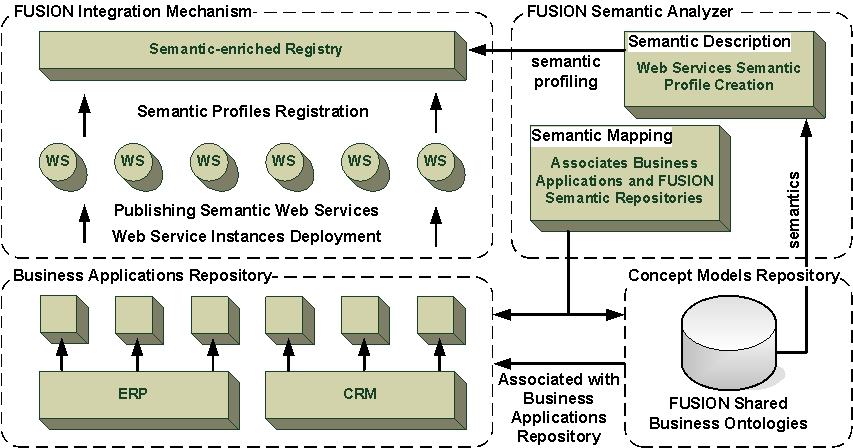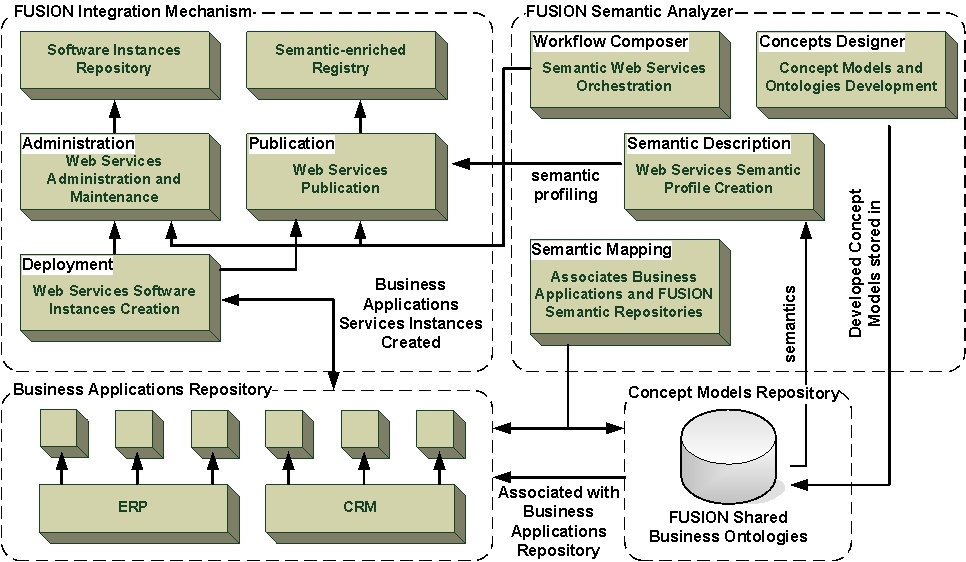February 2006–July 2008

#1.Project description
FUSION aims at the efficient business collaboration and interconnection between enterprise(including SMEs) by developing a framework and innovative technologies for the semantic fusion of service-oriented businesses applications that exist within an enterprise or in several collaborating companies, taking into consideration the intercultural and regulatory aspects of the enlarged Europe countries.FUSION will have a three-fold focus:
- FUSION aims at the development of an innovative approach, methodology and integration mechanism for the semantic integration of a heterogeneous set of business applications (ERP, CRM and other enterprise applications), platforms and languages withinSMEs.
- FUSION aims at the integration of research activities carried out in the Enlarged Europein the areas of Business Process Management, Semantic Web and Web Services
- FUSION aims at the validation of research results by developing proof-of-concept pilots in collaborative commerce growth across semantically-enriched value networks across the Enlarged Europe. In particular, FUSION will facilitate three trans-national cases.
##FUSION expected results
The 30-month FUSION project will, finally, result,through the FUSION deliverables (both reports and prototypes), in:
- R1.An innovativeFUSION approach for Semantic Service-oriented Business Applicationintegration (i.e. CRM and ERP) covering essential business processes of andbetween collaborative organizations, especially SMEs, based on increasingly familiar and stable standards that are designed to facilitate agility, loosecoupling and easy interaction, like WSDL, UDDI and SOAP.
- R2.The FUSION Methodology forSemantic Service-oriented Business Application Integration that willfacilitate the integration of business software applications that exist in thesame or different organizations
- R3.The FUSION Ontology (initial andextended version) constituting thecorner stone of SE-SOBA Integration and serving as a common reference for the association with the business application repositoriesand the semantic description of Web Services Instances,
- R4.The FUSION integration mechanism that will allow the interconnectionof heterogeneous information systems, resource sharing and services provision. The mechanism will enable the implementation of:
- A semantically enriched service registry
- A categorization and discovery service, and
- A serviceorchestration / composition featurefor service-oriented business applications based on WebServices standards (like UDDI, WSDL and SOAP) and Semantic Web technologystandards (like OWL-S or WSMO).
- R5.Three FUSION cases thatwill prove the concepts and tools of the solution, concerning three different“Enlarged Europe” use cases. All three use cases are operating in the “old” andthe “new” European part and would like to facilitate the globalization of theirbusiness by supporting the collaboration between the different legal entitiesand the interoperability of their business applications. The use cases are:
- a.a franchising firm (Germanos) having acentral storehouse unit in one country aiming to facilitate the businesstransactions between the franchisees (that are based in different countries,have different IT systems and are obliged to follow national regulations) andthe franchisor.
- b.An international Network of independentinternational career managers and HR consultants (Interjob) that wouldprovides Europe-wide career offerings and services.
- c.a chain of schools of foreign languages andcomputing (Pharos) acting in the region of the Balkans that would liketo introduce unified educational procedures and monitor the activities of thedifferent legal branches.
- R6.Wide-scale dissemination and exploitation of the project results to theS/W industry as well as to the SME market in general through the participationand involvement in the FUSION project of the Chambers of Commerce and Industry(BCCI, BU) and Innovation Transfer Centres (Steinbeis, Germany).
##FUSION Conceptual Framework and Approach
The FUSION solution is an integration framework thatfacilitates the integration of heterogeneous enterprise applications that existin the same organization or in different organizations. The way the final FUSION solution will work is described in the following.

The FUSION solution will invoke the creation, administration and deployment of Web Services Instances of the pre-selected features of theenterprise applications and their semantic description (Semantic Profile) basedon a business concept model – called FUSION ontology – that serves as a commonreference allowing the semantic integration of the business applications. Thedeployed Web Services Instances will be published at a semantic-enriched UDDIservice registry, while the created Semantic Profiles of Web Services Instances will be registered in the FUSION semantically-enriched registry, which is partof the FUSION Semantic Repository, powering the system-integratedcategorization and discovery services.
The way we envision business analysts to work with the FUSION solution is that they:
- define the concepts that exist inside thebusiness application (e.g. product, contact, order, etc) and use well-defined business ontologies / concept models that are independent from the technical architecture of the business application,
- associate the concepts and services with thebusiness application repository / resources,
- create and administrate Web Services Instances,create semantic profiles of Web Services Instances and publish the profiles onthe FUSION semantically-enriched registry, and
- orchestrate aggregate compositions of semanticweb services based on FUSION-enabled descriptions of various business applications
As mentioned above, the FUSION solution may be appliedon either Intra-Organizational Enterprise Application Integration orInter-Organizational Enterprise Application Integration to support semantic workflows and added-value supply chains.

##FUSION Technical Architecture
The Semantic Services Analyzer is a graphical environment that facilitates the semantic conceptualization of Service-Oriented Business Applications regardless their technical infrastructure. The Semantic Services Analyzer enables the utilization of the produced business conceptualization for the automatic creation of Web Services.
- The graphical environment enables system analysts toassociate the theoretical concepts to the business application resourcesproviding a connection between the system semantics and their technicalrealization.
- The Integration Mechanism is the component of theFUSION Solution responsible for the administration of the Semantic Repository(containing the Concept Models and Services Repository, the Web Services Software Instances Repository and the Semantic-enriched Service Registry), for the creation, administration and the maintenance of the Web Services and the publicationof Web Services in the semantic-enriched UDDI Registry.
- The Integration Mechanism does not offer any graphicalinterface but it communicates via SOAP with the Semantic Services Analyzer.This enables the remote creation and deployment of Web Services SoftwareInstances by a group of users, potentially from multiple legal entities, thathave the proper rights to connect to the Integration Mechanism, and theadministration of the Mechanism by authenticated personnel (e.g., in case ofinter-organizational EAI, the authenticated personnel comes from the “corepartner” of the inter-organizational supply chain that potentially owns the FUSION System).
The overview of FUSION technical architecture isrepresented / depicted in the following figure:

2.Project website
The project web site is available here.

